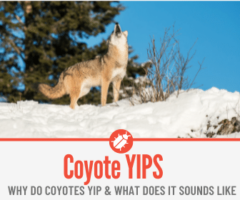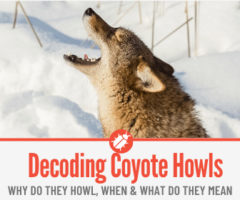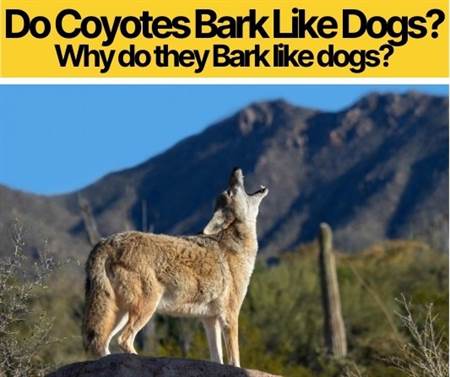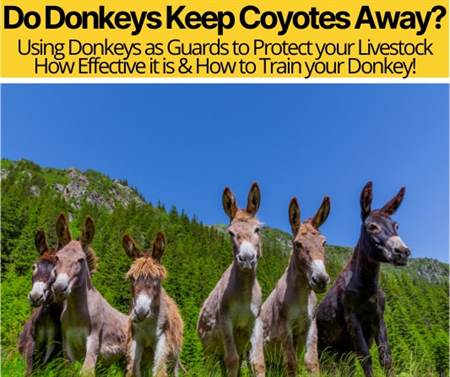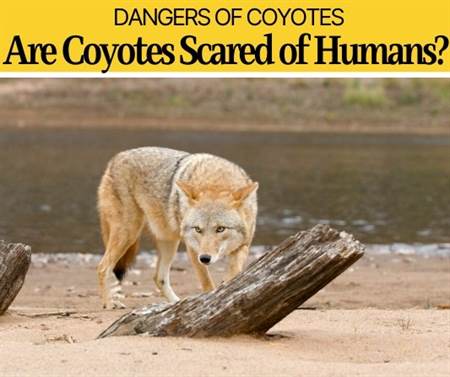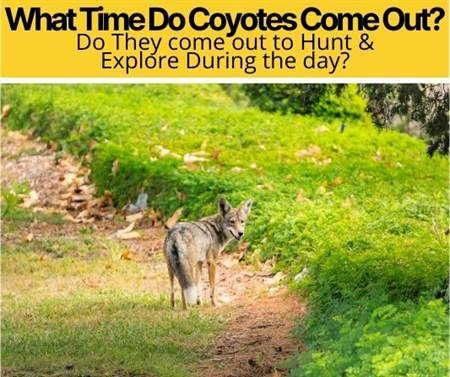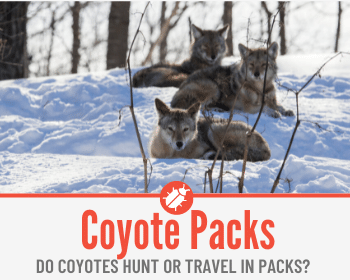 Unlike their wolf relatives, coyotes are usually seen alone. Because of this, they are often thought of as a solitary animal.
Unlike their wolf relatives, coyotes are usually seen alone. Because of this, they are often thought of as a solitary animal.
But, do coyotes ever form packs, and do they ever hunt or travel in their pack?
What is a pack?
A pack is a group of related coyotes who live by a hierarchy system to defend their family territory
The group of coyotes can also be called a band, but is most commonly called a pack.
Do Coyotes Have Packs
As a member of the canine family, coyotes are a pack, or a social animal. This means that they do have packs and even interact as a pack.
Unlike their wolf relatives, the coyote pack is smaller and usually only includes family members.
However, coyotes have been known to also be solitary animals, meaning they travel and hunt alone. These coyotes will often join a pack for a short amount of time, during winter for instance, before moving on.
How many Coyotes are in a Pack?
A coyote pack generally consists of 3 to 7 adult coyotes and 4 to 7 pups.
The Alpha Coyotes
The pack is led by an alpha male and an alpha female. These two are mated for life.
The alpha female is the only member of the pack who reproduces. Because of this, she is considered to be the most important member.
The Beta Coyotes
Making up the rest of the pack are beta coyotes and pups. Beta coyotes are adult children that do not usually reproduce but help the pack by caring for the pups born to the alpha pair.
The Pups
Coyotes mate between January to March. The alpha female usually gives birth to four to seven pups in their underground home called a den.
At six to nine months of age, the pups are considered fully grown and independent. Some pups will leave the pack in the fall, but others will remain with the pack to help care for the next set of young.
Strays
Sometimes, stray coyotes called loners will join the pack for a while. However, they often do not stay long.
These strays are called solitary coyotes. They are usually young coyotes, ranging from 6 months to 2 years old, and can be either male or female.
Often, strays have recently left another pack and are either looking for another pack to join or for their own territory to form their own pack.
Feral dogs
Sometimes, a stray, feral dog will join the pack, although it’s not as common.
Coyotes have been known to mate with feral dogs, creating an offspring known as a coydog.
More to Read: Pet Coyote Domestication.
How Big can a Coyote Pack Get?
A coyote pack can vary greatly in size, depending on different factors such as habitat, food, and predators.
The biggest factor that affects the pack’s size is the size of the alpha mates’ litter.
Coyotes have the ability to adjust the size of their litter based on the availability of food in the area and the relative danger from predators.
Protected habitat
A protected habitat is a territory that the group of coyotes can well protect.
The benefit of a protected habitat is that the alpha mates don’t have to worry about predators. Food is also generally abundant because the pack controls the area.
In this habitat, the pack size is usually large, containing 5 to 6 adult coyotes as well as all the pups born that year.
Unprotected habitat
An unprotected habitat is usually found in rural areas where hunting and trapping are quite common.
In this habitat, the pack size is quite small, containing only the alpha pair and any pups born that year.
The pack is small in an unprotected habitat because food is usually more scarce, and the alpha pair has to focus more on protecting their young from predators—both animal and human.
How Often are Coyotes in Packs
Coyotes are most often in packs during the winter. Being in close range with one another provides warmth and protection.
Often, lone coyotes will join up with a pack during the winter months and then leave in the spring to continue their journey.
Do Coyotes Hunt in Packs?
Coyotes do hunt in packs ,this however depends on the size of the prey coyotes are after.
Coyotes generally prefer to hunt alone or in loose pairs when looking for smaller prey.
But, when hunting larger prey, like a deer, coyotes will often work together and hunt as a pack.
Especially in the winter, when game is more scarce, coyotes will often hunt in packs, relying on the greater combined force to find and catch food more easily.
Hunting small Prey
Coyotes prefer to hunt alone, especially when looking for smaller prey.
What is small prey?
Because they are not picky eaters, small prey for a coyote can include many different things.
But, they also have been known to eat insects and fruits, such as watermelons, grapefruits, and apples.
In urban environments, coyotes will often scrounge for whatever food they can find. This food includes garbage, pet food, and food left by humans.
How do Coyotes hunt Small Prey?
With their keen vision, sense of smell, hearing, and speed, coyotes are often able to outrun and outsmart their prey—especially the smaller prey.
When hunting small prey alone, coyotes will often stalk their prey and then pounce on it to capture it.
Coyotes Hunting Large prey In Packs
When hunting larger prey, coyotes will often band together and hunt as a pack.
The only times you will probably see a band of coyotes hunting as a pack are when food is scarce, when there are many pups to be fed, and when it is winter.
What is large prey?
Large prey includes anything from deer to antelope. Coyotes can eat goats and sheep as well.
According to scientists, once coyotes get a taste for sheep, it is almost impossible to keep them from killing more sheep.
Although coyotes generally prefer fawns to grown deer and antelope, they have been known to bring down the full-grown animal.
Coyotes have also been known to eat livestock and human pets.
Farmers have noticed that, depending on the availability of other food, coyotes will often kill calves, and sometimes even right after the calf was born.
How do they hunt larger prey?
With their keen vision, sense of smell, hearing, and great speed, coyotes are often able to outrun and outsmart their prey.
With deer, antelope, and other fast prey, coyotes will often flank the prey to either wear them out or to move them towards a hidden coyote.
Other times, one or more coyotes will chase the large prey until another group picks off the prey.
Coyotes have also been known to stalk badgers, waiting to catch the animal that will pop out of the burrow that the badger was digging.
Sharing the catch
It is interesting to note when coyotes share their prey with other members of the pack.
If the coyote hunted the prey alone, he will be very protective and defensive of their kill. If the prey was hunted as a pack, however, then the kill is shared with all the members.
Why Do Coyotes Hunt in Packs
There are several advantages to hunting prey as a pack.
The first is conserving strength.
Working as a group makes it much easier for the pack to get a larger kill because it wearies the prey without consuming much of the coyotes’ strength.
This advantage is especially important during the winter when coyotes need to conserve their strength and energy to fight off the cold weather.
The second advantage is strategy.
With their quick whit, coyotes are known to lure or push their large prey into a trap. This setup can be seen when several coyotes push their prey into an area that looks clear, but where there are coyotes waiting to attack.
Deer are especially vulnerable to a coyote strategy in the winter because their visibility is much lower.
The third advantage is teaching their young.
Most often, when you see a pack of coyotes together, it is because there are younger coyotes in the group that are being taught how to hunt.
When the pups are old enough to begin learning to hunt, either the alpha pair or a couple of the beta coyotes will take the pups out to learn to hunt.
Do Coyotes Travel in Packs?
Because coyotes are usually seen traveling alone, people assume that coyotes never travel in packs.
It is important to note that coyotes do not always travel in packs, nor do they always travel alone.
Even though they often prefer to travel short distances alone, coyotes do understand the benefit and safety of traveling as a group.
Thus, you will see coyotes traveling in a pack, in a loose pair, and on their own—similar to how they hunt.
Short distances
Coyotes do not migrate. Instead, they have territories call home ranges.
The alpha pair will stay in their home range until they either die or are forced to move on—either by humans or other coyotes.
However, they will travel short distances to maintain the boundaries of their home range.
Maintaining the home range
Most often, coyotes are seen traveling in packs when they are maintaining their boundaries.
The benefit of traveling as a pack is the inherent safety in numbers when approaching the boundary of another pack’s territory.
Teaching the young
The second reason coyotes are seen traveling in packs is to teach the young pups how to patrol the home range and how to be on the alert for danger.
Finding food in winter
The third reason coyotes will travel in packs is to find food in the winter.
Joining forces allows coyotes to find scarce food more quickly in a cold, harsh climate where visibility is low.
Long distances
When traveling long distances, coyotes generally travel alone.
Usually, the lone coyote is a young coyote looking for his own territory and to establish his own pack.
However, lone coyotes have much less chance of survival when traveling long distances.
Lone coyotes often die from being attacked by predators or hostile coyotes, from not being able to find enough food, or from exposure to the elements.
What Does it mean When coyotes Travel in packs?
When coyotes travel in packs, it usually means that they are maintaining their home range.
Traveling packs of coyotes are often re-establishing the borders of their home range.
They do this by marking their territory with urine or by leaving scat. Scat is rope-like coyote feces that is filled with hair and bones.
When do Coyotes travel in Packs?
In the winter
Coyotes most often travel in packs in the winter.
With decreased visibility, lone coyotes are more susceptible to attacks and exposure. Traveling as a pack provides safety in numbers and increased awareness of their surroundings.
At night
Because they are generally more nocturnal animals, it is common to find packs of coyotes traveling at night.
Although they can come out during they day, they often prefer the time from dusk until dawn.
During the winter, coyotes are often more active throughout the day because there is less daylight.
Even though they prefer the night, it is important to note that coyotes will come out and hunt for food at any point in the day.
Why do Coyotes Howl in Packs?
When traveling as a pack, coyotes howl to communicate with one another and to audibly defend their territory.
Especially at night when visibility is low, coyotes will howl to communicate their location, distance, or wellbeing to the other members in the pack.
When packs of coyotes are defending their territory, howling acts as an audible reinforcement of the pack’s territory boundaries.
Continue Reading: Why Do Coyotes Howl
Are Packs of Coyotes Dangerous
Although coyotes are naturally scared of humans, they have been known to attack humans.
According to the Humane Society, there have only been two recorded instances in the United States of a coyote killing a human.
Even though these deadly attacks are quite rare, being bitten is much more common. Coyotes can carry diseases such as rabies that can kill a dog and injure a human.
When on their own, coyotes are less likely to attack a human or a human pet.
However, when they band together as a pack, they can become more bold and more dangerous.
Most often, coyotes, and even a pack of coyotes, can be easily scared off by intimidating gestures and loud noises.
When the pack becomes dangerous is when the area has had a drought or food has been scarce. At this point, coyotes will become more aggressive because they are driven by the need to find food.
Coyotes are also most aggressive during the denning season (February through June) and when protecting their young.
But, according to the Humane Society, most of the coyote attacks on a human come from the coyote having been fed by humans.
What Do You Do If You See A Pack Of Coyotes
Generally, coyotes are scared of humans and will not approach.
However, coyotes that have become accustomed to human interaction, either through feeding or exploration, can be bolder than normal coyotes.
A pack of coyotes will not generally follow a human unless they smell food on the human or are desperate.
Hazing
The best way to discourage a pack of coyotes is by hazing. Hazing is a method of deterring coyotes through loud noises and large gestures.
Ways to haze a coyote include:
- Yelling and waving your arms as you slowly walk towards the coyote
- Making loud noises by banging items together
- Spraying the coyote with water from a hose or spray bottle
- Using pepper spray, vinegar water, or bear repellent
When you see a pack of coyotes, follow the list of instructions below:
- Make yourself as big and as loud as possible. Wave your arms and clap your hands.
- Shout in a loud, commanding voice, “Go away, coyote!”
- Start slowly walking toward the pack.
- Moving toward them should intimidate them enough for them to back away or leave.
- Spray the coyote if you are within reach, and they are still not leaving.
- Maintain eye contact and continue hazing until the coyote finally leaves.
Important!
Never turn your back on a coyote or run away from it.
Doing so makes you look like a target and entices the coyote to chase you down like normal prey.
If the coyotes only move away a short distance, continue hazing.
Sometimes, the coyote will be intimidated but will only move away a short distance before stopping and staring at you.
Continue hazing until the coyote has left the area entirely.
If the coyote leaves but then returns soon after, haze him again.

